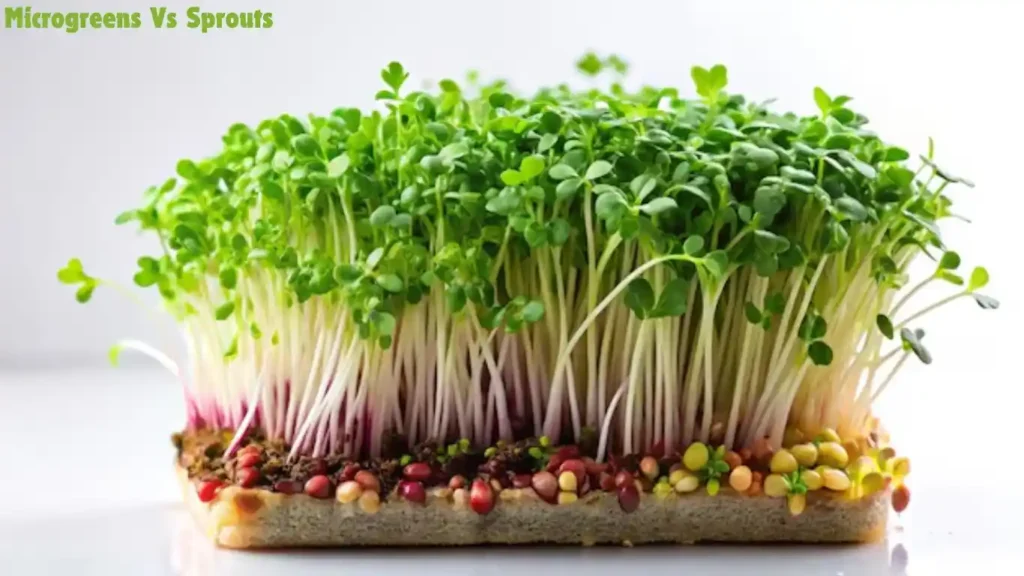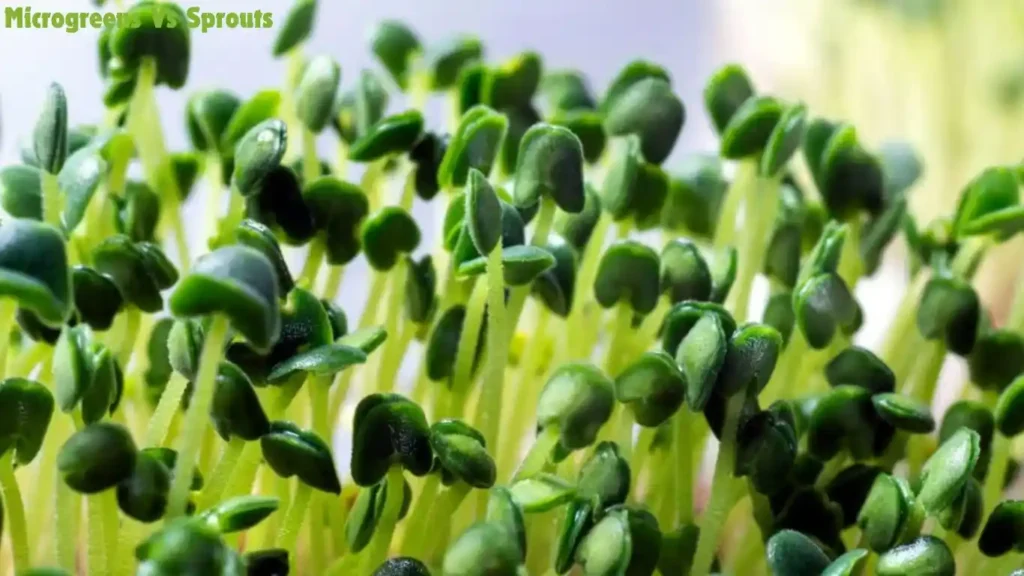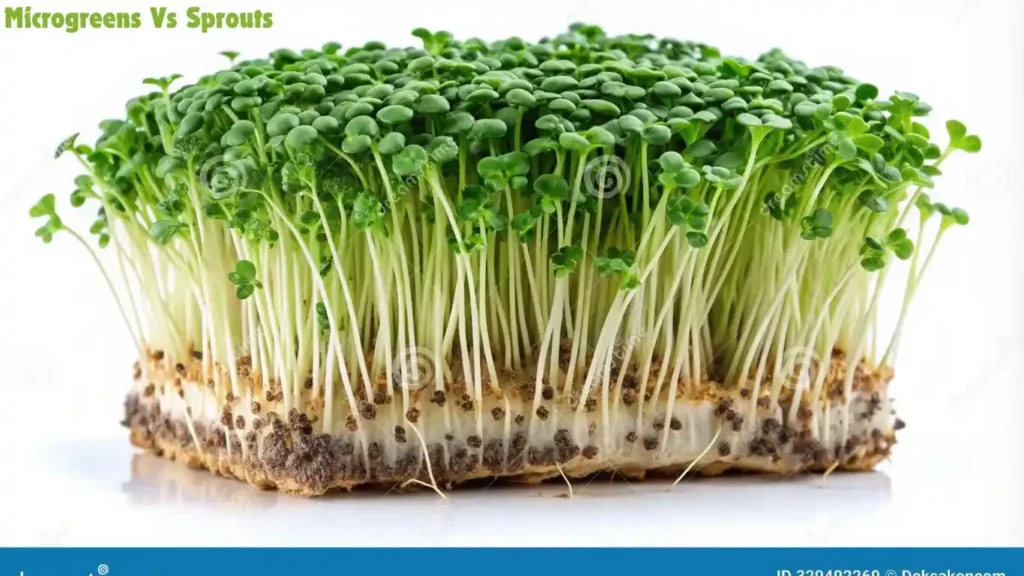Microgreens Vs Sprouts | Best & Complete Comparison
Practicing good eating habits is a preference over any other time in the present quick-moving world. We always look for nutritional, favorable possibilities to remember for our eating regimens.
Microgreens vs. sprouts and projections are two famous conclusions frequently in these exchanges. Be that as it may, what exactly are they, and how would they look? We should jump into the subtleties.
Significance of Healthy Eating
Keeping a sound eating practice is basic for general means. It supports energy levels, develops mindset, and forestalls constant conditions. With such numerous choices, we must make informed conclusions about what we eat.

Summary of Microgreens Vs Sprouts: these are both thick and simple accessories to develop at home. They are collected at different stages of plant development, affecting their healthful substance, taste, and culinary ideals.
Understanding the differences between microgreens vs. sprouts and beginners can assist you with determining which to place for your eating regimen.
Common Types of Microgreens Vs Sprouts
There is an expansive variety of microgreens vs. sprouts in general, each with unique flavors and nutritional shapes. Some popular types include:
Arugula: Known for its peppery flavor, arugula microgreens add a tangy kick to words.
Basil: These microgreens are sweet, aromatic, and perfect for Italian dishes.
Beet Greens: Beet microgreens vs. sprouts offer a soft, earthy taste and deep color.
Cilantro: With a fresh, citrusy flavor, cilantro microgreens vs. sprouts are great for Mexican and Asian cooking.
Radish Greens: These have a sharp, tangy flavor similar to mature radishes.
Nutritional Benefits of Microgreens Vs Sprouts
Microgreens vs. sprouts are thick supplements and offer medical advantages because they highly concentrate nutrients, minerals, and cell support.
Nutrients and Minerals: Microgreens vs. sprouts are plentiful in nutrients C, E, and K. They also contain critical measures of beta-carotene and lutein, which are critical for keeping up with eye well-being.
The complement content can be multiple times higher than mature plants, making them a solid addition to any eating regimen.
Compartment support Properties: These tiny greens are also high in cell fortifications, which help fight oxidative anxiety in the body.
Malignant growth expectation experts are essential for saving cells from harm, decreasing exacerbation, and diminishing the bet of constant conditions like coronary disease and condition.
Growth and Cultivation
Developing involves various methods, each with its own requirements and steps.
How Microgreens Are Originated: Microgreens vs. sprouts are commonly filled in soil or used as a dirt replacement for coconut coir or tank-farming mats. Here is an entire aid:
Pick Your Seeds: Select top-notch seeds explicitly named for microgreens vs. sprouts.

Set up a Compartment: Utilize a surface plate with waste openings.
Add Soil: Fill the container with a light, well-depleting soil mixture.
Plant Seeds: Dissipate the seeds uniformly over the dirt and cover them delicately.
Water: Saturate the dirt using a rain jug to avoid dislodging the seeds.
Light: Spot the plate in a bright location or underdeveloped lights.
Reap: Cut the microgreens vs. sprouts simply over the ground level when they are 1-3 inches tall, primarily within 1-3 weeks.
Sprouts are supplied in water, and the cycle is direct:
Pick Your Seeds: Select seeds for growing to ensure well-being and quality.
Splash Seeds: Spot the seeds in a receptacle and cover them with water. Allow them to water for 8-12 hours.
Channel and Wash: After moistening, simply channel the water and wash the seeds.
Growing: Spot the container in a dull, warm spot. Wash and conduct the seeds 2-3 times each day.
Reap: Beginners are prepared to eat in 2-7 days. Wash them entirely before destroying them.
Taste and Texture
Both offer specific flavors and surfaces that can raise different dishes.
Flavor Profiles of Microgreens: Microgreens vs. sprouts have more robust flavors that contrast with those of their extended partners. For example, mustard microgreens vs. sprouts are hot, while beet microgreens vs. sprouts have a sweet, gritty taste.
Their full-bodied flavors make them an incredible expansion to mixed greens, soups, and sandwich servings.
Flavor Profiles of Beginners: Grows, by and large, have a new, fresh flavor. Hay sprouts are soft, making them universal for different dishes. Interestingly, radish sprouts are hot and add a peppery spice.
The surface of beginners is crunchy, adding a proper differentiation to different fixings.
Uses in Cooking
Both microgreens vs. sprouts and beginners can be used imaginatively in the kitchen to improve dinners’ health benefits and charm.
Culinary Ideals of Microgreens: Microgreens vs. sprouts are often utilized as flourishes because of their energetic types and profound flavors. Here are a few famous goals:

Mixed greens: Add a small group of microgreens vs. sprouts to composite plates of mixed greens for other surfaces and flavors.
Sandwiches: Use microgreens vs. sprouts rather than or close by lettuce.
Smoothies: Mix microgreens vs. sprouts into smoothies for accessory mounting.
Trims: Spot microgreens vs. sprouts over soups, omelets, or fundamental dishes for a new, energetic touch.
Culinary Uses of Microgreens Vs Sprouts
Sprouts are adaptable and can be employed in different ways:
Mixed greens: Design sprouts into plates of mixed greens for counted crunch and sustenance.
Sandwiches and Wraps: Use nodes as a crunchy layer in sandwiches and wraps.
Pan-sears: Add beginners to sautés for a quick, complement thick choice.
Smoothies: Mix sprouts into smoothies for an additional complement of significance.
Garnishes: Use Microgreens Vs sprouts to fix avocado toast, yogurt, or soups.
Health Benefits
Both microgreens Vs sprouts offer different clinical benefits, making them essential additions to a fair eating pattern.
Microgreens and Sickness Execration: Microgreens vs. sprouts are piled with cell fortifications, which help protect the body against oxidative strain and irritation.
These properties are associated with a decreased bet of tireless conditions like coronary sickness, diabetes, and typical sorts of illness.
For example, red cabbage microgreens vs. sprouts have been found to cut down levels of LDL cholesterol and liver fatty substances.
Children and Stomach-related Prosperity: Microgreen vs. sprouts are rich in powers that help manage and work on accessory digestion. They, in like manner, contain dietary fiber, which is important for keeping a sound stomach-related structure.
The budding framework separates antinutrients like phytic dangerous, making it more direct for the body to hold minerals like iron and zinc. Besides, broccoli sprouts contain sulforaphane, a compound with dangerous development-engaging effects.
Safety References
While microgreens Vs sprouts are nutritious, accepting well-being angles is essential to bypass potential well-being risks.
Likely Dangers of Microgreens: Microgreens Vs Sprouts are, for the most part, safe to eat. Yet, they can be helpless in shaping products if not developed or put away correctly. To limit possibilities:
Utilize Clean Soil: Start with clean, perfect soil to decrease the risk of tainting.
Sufficient Light and Wind Stream: Ensure appropriate light and wind current for the forestall shape.
Reap and Store Properly: Collect microgreens vs. sprouts presently and store them in the fridge to keep up with identity.
Expense and Accessibility
The payment and exposure of microgreens vs. sprouts and beginners can shift, contingent upon where and how they are bought or designed.
Valuing of Microgreens: Microgreens vs. sprouts can be more expensive than sprouts, mainly bought from a store or herder’s market. This is because of the more ample developing time frame and the necessity for soil or a developing medium.
Be that as it may, developing microgreens at home can fundamentally decrease costs.
Valuing of Beginners: Microgreens Vs Sprouts are by and large more affordable and can be found in most supermarkets. They are thrift to develop at home, needing just seeds, water, and a growing container.
This makes growth a functional method for keeping your complement consumption.
Environmental Impact
Considering the natural effect of developing microgreens Vs sprouts is important for maintaining maintainable conclusions.
Manageability of Growing Microgreens: Developing microgreens vs. sprouts is possible. They require less water and land than traditional cultivating.
Also, they can be created inside, lessening the necessity for transportation and bundling. Living soil or developing mediums can have an ecological effect, delegation upon the source and technique employed for removal.
Manageability of Developing Fledglings: Microgreens vs. sprouts have an even lower natural impression. They require little water and can be developed without soil, which decreases asset use.
The short action cycle likewise means they can be created rapidly and with less energy than products.
Growing Your Microgreens Vs Sprouts
Growing microgreens vs. sprouts at home can be a fun and rewarding venture. Here’s how to do it:
Bit by Bit Guide
Pick Your Seeds: Select top-caliber, natural seeds.
Set up a Compartment: Use a shallow plate with seepage spaces.
Add Soil: Fill the plate with a light, well-depleting soil blend.
Plant Seeds: Sprinkle the seeds equally over the dirt and cover delicately.
Water: Dampen the dirt using a splash bottle.
Light: Spot the plate in a bright spot or underdeveloped lights.
Assemble: Cut the microgreens vs. sprouts simply over the dirt level when they are 1-3 inches tall.
Conclusion
Microgreens Vs sprouts are awesome increments to a sound eating regimen, each offering special flavors, surfaces, and dietary benefits.
Whether you favor the serious kinds of microgreens vs. sprouts or the new taste of beginners, combining these little plants into your dinners can help your accessory consumption and culinary originality.
FAQS
Can you eat raw microgreens?
In addition to their nutritional value, they can add flavor, surface, and color to salads and sandwiches. People can also add them to smoothies or use them as a garnish. They are reasonable for eating raw, meaning they maintain their vitamin and mineral content.
Is it OK to eat microgreens every day?
Yes, you can eat microgreens every day as part of a level diet. Yet, it’s important to note that microgreens should not be the only source of nutrients in your diet and should be finished in addition to other fruits, vegetables, whole cereals, and wasted proteins.
Can I eat microgreens instead of vegetables?
Microgreens can be a healthy complement to a level diet, but they should not be used as a replacement for vegetables.
Do microgreens regrow after cutting?
Microgreens are generally not regrown after the initial yield. The only microgreens that you can regrow is Pea and You can regrow it only once.
Do you wash microgreens?
It would help if you rinsed your microgreens. Yes, I know eating out of the container (or right out of the living tray) is more convenient, but you do want to irrigate them off nevertheless.
Are microgreens healthier than spinach?
On the other hand, fenugreek and onion microgreens are the least nutrient-dense. Also, the estimated NQS informed that all microgreens were 2–3.5 times more nutrient-dense than adult leaves of spinach grown beneath equal conditions.
Is moong a microgreen?
Organic Mung Beans are easy to grow as microgreens at home. Sowing to gather generally takes between 8-12 days, so you can quickly enjoy fresh, nutrient-rich microgreens.

One Comment